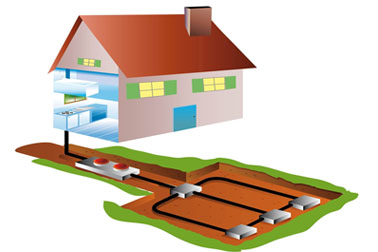 By TreeLiving Geothermal heat pump systems (GHPs) use the earth as a heat source (in the winter) or a heat sink (in the summer). Basically, they use the relatively constant temperature of the earth (below the frost line) rather than heating and cooling the highly variable, above-ground air. The warmth is then circulated through the building and returned to the earth to be warmed again. In the summer, the reve rse occurs. The temperature below the earth's surface is cooler during warm months, and the system extracts heat from the building and puts it back into the earth, where it is cooled by the earth and returned to the building. This is why GHPs are sometimes called “Geo Exchange” systems. There are two main types of GHPs: open loop and closed loop. Both types of systems have a heat pump that is installed inside the building, usually in the basement. Both open-loop and closed-loop GHPs rely on the heat pump to heat or cool the fluid in the pipes; but because the fluid is a constant temperature, having come from the earth, the amount of energy required to get the fluid to the correct temperature is minimal. Advantages of geothermal heat pumps Energy saving – Geothermal heat pumps can reduce energy consumption up to almost 80% compared to electric resistance heating with standard air-conditioning equipment Durability – Geothermal systems have relatively few moving parts that must be sheltered inside a building. These characteristics provide durability and high reliability. Versatility – Geothermal systems are compatible with small spaces or large areas. They can be set underground under asphalt or concrete or they can be laid horizontally. They can even be placed on the bed of a sufficiently-sized body of water. Money saving – Even though the installation price of a geothermal system can be very expensive, those costs are returned to you in energy savings in less than five years. Eco-friendly – Geothermal heat pumps are more environmentally friendly compared to conventional systems because they not burn fuel, the system collect the Earth's natural heat through a series of pipes that cause no direct emissions to the environment.
By TreeLiving Geothermal heat pump systems (GHPs) use the earth as a heat source (in the winter) or a heat sink (in the summer). Basically, they use the relatively constant temperature of the earth (below the frost line) rather than heating and cooling the highly variable, above-ground air. The warmth is then circulated through the building and returned to the earth to be warmed again. In the summer, the reve rse occurs. The temperature below the earth's surface is cooler during warm months, and the system extracts heat from the building and puts it back into the earth, where it is cooled by the earth and returned to the building. This is why GHPs are sometimes called “Geo Exchange” systems. There are two main types of GHPs: open loop and closed loop. Both types of systems have a heat pump that is installed inside the building, usually in the basement. Both open-loop and closed-loop GHPs rely on the heat pump to heat or cool the fluid in the pipes; but because the fluid is a constant temperature, having come from the earth, the amount of energy required to get the fluid to the correct temperature is minimal. Advantages of geothermal heat pumps Energy saving – Geothermal heat pumps can reduce energy consumption up to almost 80% compared to electric resistance heating with standard air-conditioning equipment Durability – Geothermal systems have relatively few moving parts that must be sheltered inside a building. These characteristics provide durability and high reliability. Versatility – Geothermal systems are compatible with small spaces or large areas. They can be set underground under asphalt or concrete or they can be laid horizontally. They can even be placed on the bed of a sufficiently-sized body of water. Money saving – Even though the installation price of a geothermal system can be very expensive, those costs are returned to you in energy savings in less than five years. Eco-friendly – Geothermal heat pumps are more environmentally friendly compared to conventional systems because they not burn fuel, the system collect the Earth's natural heat through a series of pipes that cause no direct emissions to the environment.
Geothermal Heat Pumps

